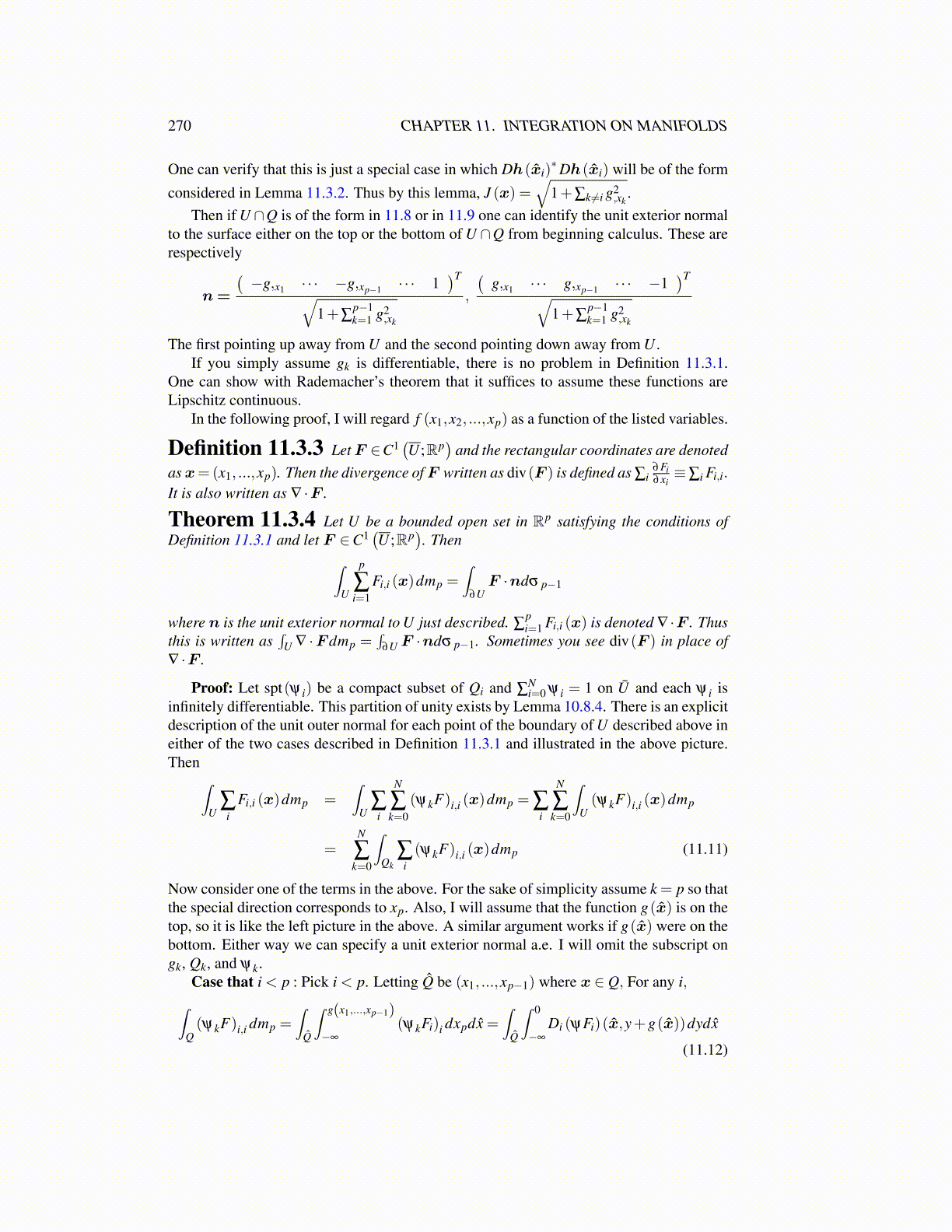
270 CHAPTER 11. INTEGRATION ON MANIFOLDS
One can verify that this is just a special case in which Dh(x̂i)∗Dh(x̂i) will be of the form
considered in Lemma 11.3.2. Thus by this lemma, J (x) =√
1+∑k ̸=i g2,xk
.Then if U ∩Q is of the form in 11.8 or in 11.9 one can identify the unit exterior normal
to the surface either on the top or the bottom of U ∩Q from beginning calculus. These arerespectively
n=
(−g,x1 · · · −g,xp−1 · · · 1
)T√1+∑
p−1k=1 g2
,xk
,
(g,x1 · · · g,xp−1 · · · −1
)T√1+∑
p−1k=1 g2
,xk
The first pointing up away from U and the second pointing down away from U .If you simply assume gk is differentiable, there is no problem in Definition 11.3.1.
One can show with Rademacher’s theorem that it suffices to assume these functions areLipschitz continuous.
In the following proof, I will regard f (x1,x2, ...,xp) as a function of the listed variables.
Definition 11.3.3 Let F ∈C1(U ;Rp
)and the rectangular coordinates are denoted
as x=(x1, ...,xp). Then the divergence of F written as div(F ) is defined as ∑i∂Fi∂xi≡∑i Fi,i.
It is also written as ∇ ·F .
Theorem 11.3.4 Let U be a bounded open set in Rp satisfying the conditions ofDefinition 11.3.1 and let F ∈C1
(U ;Rp
). Then∫
U
p
∑i=1
Fi,i (x)dmp =∫
∂UF ·ndσ p−1
where n is the unit exterior normal to U just described. ∑pi=1 Fi,i (x) is denoted ∇ ·F . Thus
this is written as∫
U ∇ ·F dmp =∫
∂U F ·ndσ p−1. Sometimes you see div(F ) in place of∇ ·F .
Proof: Let spt(ψ i) be a compact subset of Qi and ∑Ni=0 ψ i = 1 on Ū and each ψ i is
infinitely differentiable. This partition of unity exists by Lemma 10.8.4. There is an explicitdescription of the unit outer normal for each point of the boundary of U described above ineither of the two cases described in Definition 11.3.1 and illustrated in the above picture.Then∫
U∑
iFi,i (x)dmp =
∫U
∑i
N
∑k=0
(ψkF)i,i (x)dmp = ∑i
N
∑k=0
∫U(ψkF)i,i (x)dmp
=N
∑k=0
∫Qk
∑i(ψkF)i,i (x)dmp (11.11)
Now consider one of the terms in the above. For the sake of simplicity assume k = p so thatthe special direction corresponds to xp. Also, I will assume that the function g(x̂) is on thetop, so it is like the left picture in the above. A similar argument works if g(x̂) were on thebottom. Either way we can specify a unit exterior normal a.e. I will omit the subscript ongk, Qk, and ψk.
Case that i < p : Pick i < p. Letting Q̂ be (x1, ...,xp−1) where x ∈ Q, For any i,∫Q(ψkF)i,i dmp =
∫Q̂
∫ g(x1,...,xp−1)
−∞
(ψkFi)i dxpdx̂ =∫
Q̂
∫ 0
−∞
Di (ψFi)(x̂,y+g(x̂))dydx̂
(11.12)